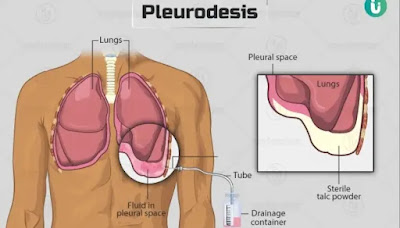Mesothelioma of Pleura Unknown Facts, Line of Treatment, Causes & More
Mesothelioma of Pleura: Pleural mesothelioma refers to a form of lung lining cancer known as the pleura, typically triggered by the inhalation of asbestos fibers. Around 80-90% of mesothelioma cases are diagnosed as malignant pleural mesothelioma.
Some of the most common indicators of this condition encompass difficulties in breathing, a persistent dry cough, and chest discomfort. Please note that mesothelioma of pleura is the same as pleural mesothelioma.
What Is Pleural Mesothelioma?
Malignant
pleural mesothelioma represents an uncommon form of cancer affecting the lining
encasing the lungs, known as the pleura.
This
condition arises from exposure to asbestos fibers. Upon inhalation, these
fibers can penetrate the pleura, provoking inflammation and tissue scarring.
Gradually, this sequence of events may culminate in the formation of
mesothelioma tumors.
How to Understand Mesothelioma Asbestosis? Do These Terms
Pleural Mesothelioma Facts
- Malignant pleural mesothelioma stands as the most prevalent form of mesothelioma cancer.
- Symptoms include chest pain, dry cough, fatigue, and shortness of breath.
- While some patients have experienced extended survival post-aggressive treatment, it's not considered curable.
- Prognosis varies per individual, with an average life expectancy of approximately 18 months.
- Around 2,500 people receive mesothelioma of pleura diagnosis annually.
- Diagnosis involves various tests such as scans and biopsies.
- Treatment often combines chemotherapy, surgery, radiation therapy, and immunotherapy.
Mesothelioma of Pleura Prognosis
The
prognosis for mesothelioma of pleura hinges on several factors, much like other
forms of this cancer. Without treatment, the median survival time is typically
around six months. However, certain treatments, like a combination of surgery
and chemotherapy, have shown potential to enhance life expectancy.
Survival
rates for mesothelioma of pleura at various intervals post-diagnosis are as
follows:
1 year
after diagnosis: 73%
3 years
after diagnosis: 23%
5 years
after diagnosis: 12%
10 years
after diagnosis: 4.7%
The key
prognosis factors for pleural malignant mesothelioma patients include:
Cell Type
(Histopathology): The most common cell type diagnosed in pleural mesothelioma
is epithelioid, which tends to form solid sheets or cord arrangements and
responds better to treatment. Patients with this cell type typically survive
around 19 months.
Stage of
Mesothelioma: Staging plays a crucial role in determining prognosis, with early
stages often offering more treatment options and better outcomes compared to
advanced stages.
Patient’s
Gender and Age: Gender and age can also influence prognosis, although the
impact varies among individuals.
The
epithelioid cell type generally shows better responsiveness to treatment
compared to sarcomatoid and biphasic types. Sarcomatoid mesothelioma tends to
be more resistant to treatment, leading to a prognosis of about eight months,
while biphasic mesothelioma outcomes depend on the dominant cell type.
Recent
data indicates improved survival rates for malignant pleural mesothelioma
patients due to advancements in treatments and diagnostics. Long-term
survivors, like Heather Von St. James, diagnosed in 2005 with a 15-month
prognosis, have defied expectations due to tailored treatments and care, with
some achieving more than a decade and a half of survival.
What Causes Pleural Mesothelioma?
pathways
that result in DNA damage, potentially leading to the formation of mesothelioma
tumors.
In
addition to asbestos exposure, other factors that might contribute to
mesothelioma development include:
Erionite
Exposure: Similar to asbestos, erionite—a natural mineral—has been associated
with mesothelioma and lung cancer due to its carcinogenic properties.
Radiation
Exposure: Previous radiation therapy for cancer treatment, while targeting
cancer cells, may inadvertently damage healthy cells and potentially increase
the risk of developing mesothelioma, although this connection is not fully
established.
What Are the Symptoms of Pleural Mesothelioma?
Following
asbestos exposure, it can take anywhere from 10 to 50 years before symptoms of
pleural mesothelioma manifest. These symptoms typically initiate within the
chest cavity and respiratory system.
Symptoms
of Pleural Mesothelioma include:
- Chest pain
- Coughing up blood
- Difficulty swallowing
- Dry cough
- Fatigue
- Fever
- Presence of fluid in the lung (pleural effusion)
- Night sweats
- Shortness of breath (dyspnea)
- Weight loss
As the
disease progresses, additional and exacerbated symptoms may emerge. For
instance, at stage 4, symptoms could encompass coughing up blood and swallowing
difficulties.
Moreover,
individuals diagnosed with pleural malignant mesothelioma may also present with
concurrent asbestos-related conditions, potentially influencing the onset and severity
of symptoms.
Pleural Effusion
Pleural
effusion occurs when an abnormal amount of fluid collects in between the two
layers of the pleura. This fluid can compress the lungs, making it difficult to
breathe. Pleural effusion and associated breathing problems are common symptoms
in pleural mesothelioma.
Pleural Plaques
Pleural
plaques are areas of thickened tissue on the surface of the pleura. Pleural
plaques often do not cause symptoms. This condition is one of the most common
side effects of asbestos exposure. Asbestos-exposed individuals with pleural
plaques may have an elevated risk of developing mesothelioma.
Pleural Thickening
Pleural
thickening is a condition in which scar tissue thickens the pleura. Pleural
thickening can be benign or malignant. It is caused by asbestos exposure and
other conditions that cause inflammation. According to one study, the majority
of pleural mesothelioma patients experience pleural thickening.
Asbestosis
Asbestosisis a chronic lung condition resulting from the inhalation of asbestos fibers, characterized by benign effects. It manifests as a type of pulmonary fibrosis, leading to the formation of scar tissue in the lungs.
The scarring reduces lung flexibility,
making breathing more challenging. Additionally, individuals with asbestosis
might face an elevated likelihood of developing pleural mesothelioma.
It's
important to note that these conditions related to asbestos exposure, such as
asbestosis, can arise separately from pleural mesothelioma.
How Is Pleural Mesothelioma Diagnosed?
Diagnosing
pleural mesothelioma typically involves a series of tests. Initially, imaging
scans like X-rays or CT scans are conducted to detect tumors or signs of
disease spread. If a tumor is identified, blood tests might be performed to
detect specific biomarkers, aiding in distinguishing mesothelioma from other
conditions.
Currently,
a biopsy remains the definitive method to confirm a diagnosis of malignant
pleural mesothelioma. Procedures like thoracentesis or thoracoscopy are
employed to obtain tissue or fluid samples for analysis. Thoracentesis involves
using a fine needle to extract fluid buildup in the chest.
Thoracoscopy,
a more invasive procedure, involves inserting a thoracoscope into the chest to
examine the lungs and pleura. Tissue samples or fluid can be collected for
analysis during this process. Following the biopsy, a pathologist examines the
cells to provide a conclusive diagnosis, determining the cell type and
predicting the disease's progression.
Malignant Pleural Mesothelioma Stages
As part of
the diagnostic process, a mesothelioma specialist evaluates the disease's
stage, indicating its extent of spread, crucial for prognosis and treatment
decisions.
Life
Expectancy for Pleural Mesothelioma by Stage:
Stage 1:
Approximately 21 months
Stage 2:
Around 19 months
Stage 3:
Roughly 16 months
Stage 4:
About 12 months
The
commonly used TNM staging system assesses the tumor's size, lymph node
involvement, and distant organ metastasis. Stages 1 and 2 typically denote
limited spreading, while advanced stages may involve metastasis to lymph nodes
and other organs.
Once the
stage is identified, the medical team can tailor an effective treatment plan
for the individual's specific case.
Pleural Mesothelioma Treatment Options
Pleural
mesothelioma treatment typically adopts a multimodal strategy, combining
standard methods such as surgery, chemotherapy, and radiation. The specific
treatment plan is determined based on factors like cell type and disease stage,
although these plans are not primarily aimed to cure the disease.
Surgery is
a common approach for pleural mesothelioma. It can be aggressive, aiming to
extend life expectancy, or less aggressive, focused on alleviating symptoms.
For
early-stage malignant pleural mesothelioma, surgery might be an option. One
common surgical method is Pleurectomy/Decortication (P/D), which involves
removing the lining of the lung and chest wall, along with affected tissues and
organs.
Another
option, Extrapleural Pneumonectomy (EPP), is a more aggressive procedure,
involving the removal of the impacted lung, part of the diaphragm, and the
linings of the heart and lungs. Recent trials have indicated that these
surgeries, especially when combined with chemotherapy and/or radiation, can potentially
extend life expectancy to approximately three years.
Doctors
often advise chemotherapy as an adjunctive measure either before or after
surgery or as the primary therapy for patients with advanced disease. The most
common prescribed combination therapy involves pemetrexed (Alimta®) and
cisplatin, although ongoing research explores novel combinations. Radiation
therapy may also be recommended for specific patients to shrink tumors and
alleviate symptoms.
Cost
considerations are crucial when determining treatment for pleural mesothelioma.
Reports indicate that a single course of Alimta® treatment may exceed $50,000,
while surgeries such as a pneumonectomy can cost a minimum of $17,000.
Understanding
treatment expenses alongside the potential risks and benefits of available
therapies is pivotal for patients and their families as they navigate treatment
decisions.
Dr. David Sugarbaker, Baylor College of Medicine, His Role towards
Emerging and Experimental Treatments
Malignant
pleural mesothelioma, being the predominant type, attracts the focus of
experimental treatments. Immunotherapy, gene therapy, and photodynamic therapy
have displayed early successes in various clinical trials, showing promise in
extending life expectancy.
Advancements
in standard treatments are also underway. For instance, a study tested
pleurectomy/decortication or extrapleural pneumonectomy combined with heated
chemotherapy washes.
Results
revealed:
A median
survival of 35.3 months
A median
progression-free survival of 27.1 months
This
approach notably enhanced both overall survival and progression-free survival
compared to earlier studies.
Researchers
persist in exploring treatment options for mesothelioma, aiming to reduce
recurrence rates and stall disease progression for patients.
Pleural Mesothelioma FAQS
Is pleural
mesothelioma curable?
While
there's currently no cure for pleural mesothelioma, several treatment
approaches exist that can potentially enhance life expectancy and manage
symptoms.
How long
do pleural mesothelioma patients live?
Yes, on
average, the life expectancy for a pleural mesothelioma patient is
approximately 18 months.
What are
the symptoms of pleural mesothelioma?
The
symptoms you've listed are indeed commonly associated with pleural
mesothelioma. Recognizing these signs is crucial for early detection and timely
medical intervention
What
causes pleural mesothelioma?
Pleural
mesothelioma is caused by the inhalation of asbestos fibers
Biphasic Mesothelioma Diagnosis, Cell Types, Treatment &




Comments
Post a Comment